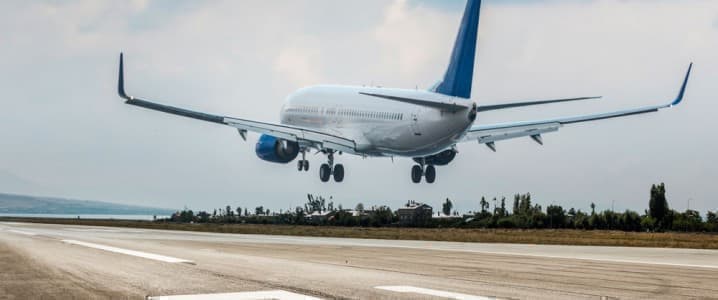The race for low and no-carbon jet fuel is well underway. In a bid to bounce back after the 2020 pandemic restrictions that sent many airlines into bankruptcy, companies across the aviation industry are competing to find the most reliable and efficient low-carbon jet fuel or fuel alternative in response to international and consumer pressure, particularly following the recent COP26 summit.
In 2019, CO2 emissions from the commercial aviation industry totaled 918 million metric tonnes, up 29 percent from 2013. While the aviation industry currently makes up just 2.5 percent of global emissions, this figure is expected to rise sharply in the coming decades, with emissions tripling over the next 30 years if passenger travel continues to grow at its current rate, increasing by around 300 percent between 1990 and 2019.
Now, with pressure from international organizations, governments, and environmental activists, airlines are finally looking to decarbonize in line with country aims for net-zero. In October, the International Air Transport Association (IATA) announced its plan for net-zero carbon emissions by 2050, following several similar pledges from European and U.S. airlines.
One of the biggest difficulties in decarbonizing is the need to reduce carbon emissions at the same time as passenger numbers increase, meaning more flights every year, with an anticipated 10 billion people flying annually by 2050.
Several airlines around the globe are already racing to develop low-carbon fuels or fuel alternatives such as electric batteries and hydrogen cells to power their flights. But experts suggest we are still a decade or more away from achieving the technology required to run commercial passenger flights on electricity or hydrogen. While these technologies continue to be developed, the aviation industry has come to rely heavily on sustainable aviation fuel (SAF) to offer a low-carbon solution in the meantime.
Just recently, British Airways (BA) took an important step towards carbon neutrality, debuting its SAF flight at COP26, but not everyone was so enthusiastic. BA’s SAF used recycled cooking oil, teamed with a more efficient and streamlined plane design, as well as relying on air traffic control to support emissions reduction, with a total emissions decrease of 62 percent in comparison to the equivalent trip in 2010. However, as BA offset its carbon emissions on the flight, the company was able to call this flight “carbon neutral”, a potentially problematic means of decarbonizing air travel.
While the carbon-neutrality of the BA flight may be questionable, it did demonstrate the advances in SAF technology and its potential for bridging the gap until totally carbon-free alternatives are available. SAF uses sustainable feedstock such as cooking oil, agricultural waste, and solid waste from homes and businesses, such as packaging and food scraps that typically go to the landfill in its production. Most importantly, SAF can reduce carbon emissions by up to 80 percent compared to traditional jet fuel.
In September, more than 50 airlines, energy firms, and other companies, including Delta, BP, and Boeing, pledged to replace 10 percent of global jet fuel supply with SAF by 2030, which currently accounts for only 0.1 percent of the aviation industry’s fuel supply. Energy companies are now making grand promises, such as Shell’s aim of producing 2 million metric tonnes of SAF a year by 2025, up from none today. And, more ambitiously, Emirates announced this week that it would be launching a test flight powered entirely by SAF by the end of 2022. This goes hand-in-hand with the U.S. government Grand Challenge, with the U.S vowing to produce 3 billion gallons of SAF by 2030, and producing enough by 2050 to power 100 percent of the aviation fuel demand in the U.S. Singapore has made a similar pledge for its international airport and national airline, Singapore Airlines Ltd., introducing a one-year pilot program using SAF throughout 2022.
There are also hopes of using carbon capture and storage technology to make use of the CO2 waste created in energy production and industry to fuel aviation. In January this year, researchers at the University of Oxford announced that they had developed a carbon-neutral jet fuel by converting CO2 using an inexpensive iron-based catalyst. This could provide the low-cost alternative to expensive SAF, which is currently around three to four times more expensive than kerosene, that airlines are searching for.
But greater investment in the development of SAF should not come at the detriment of long-term zero-carbon alternatives such as electric batteries and hydrogen fuel cells, which require significantly more funding and research to develop a sustainable energy source for commercial passenger planes within the next decade. Responding to Paris Agreement objectives as well as new global aims coming out of COP26, it is important that energy companies, the aviation industry, and governments around the globe do not put all their eggs in one basket. Instead, it is necessary to invest in a diverse range of technology to produce several zero-carbon solutions for the future of travel.
ADVERTISEMENT
By Felicity Bradstock for Oilprice.com
More Top Reads From Oilprice.com:
- Could An Energy Crunch Lead To A Worldwide Financial Crisis?
- Demand Uncertainty Could Keep Oil From Breaking $100
- U.S. Natural Gas Prices Could Soon Hit $6


















